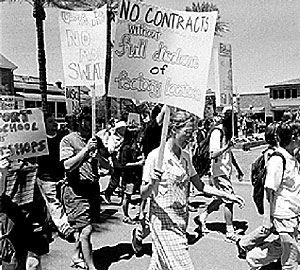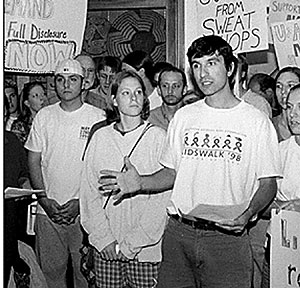 |
|
RANDY METCALF/Arizona Daily Wildcat file photo
|
Students Against Sweatshops demonstrators march along the UA Mall to the Administration building in April 1999. Activists chanted slogans and performed a skit during the protest.
|
|
|
By Mitra Taj
Arizona Daily Wildcat
Thursday, April 29, 2004
Print this
Likins says UA 'national leader' in labor movement; others have doubts
Five years ago this week, President Peter Likins was a visitor in his own office. A group of about 40 UA students were living on the seventh floor of the administration building, refusing to budge until Likins agreed to meet their demands: to stop labor abuses in the factories that manufacture UA clothing.
The UA's Students Against Sweatshops began the protest on April 21, 1999, and continued the sit-in for 10 days.
At the end of the standoff, a two-page declaration was produced, committing the president to the elimination of such abuses.
Activists sang to celebrate what they hoped would be a big step toward protecting workers around the world from inhumane working conditions.
Five years later, while Likins says the sit-in transformed the UA into a "national leader" among universities in the anti-sweatshop movement, others aren't so sure.
According to a report presented to Likins yesterday, the UA has made significant progress, especially in affiliating the university with independent factory monitors.
But the report, released by the Faculty Senate Task Force for Monitoring Human Rights and Labor Issues, also acknowledges that the UA could do more.
"It seemed simple to just get a code of conduct," said Rachel Wilson, a law student and campus activist who participated in the sit-in five years ago. "But we were naive in thinking the university would enforce the code of conduct, naive in thinking that Likins would honor his promises."
Although Wilson said Likins has disappointed SAS, she said she has also seen unexpected gains in the battle to eliminate sweatshop labor.
"We didn't think these changes would have an effect on workers for years to come," Wilson said.
 |
|
Sometimes the people in SAS get too involved in abstractions and ideological quarrels.
- President Peter Likins
|
 |
Next year, members of the task force are hoping the UofA Bookstore will sell shirts that monitoring organizations guarantee were not made in sweatshops.
Also, in accordance with the commitment, a provision for the disclosure of factory names and locations has been written into all new and renewal apparel licensing contracts.
"Now SAS can contact the UA and let the university know of abuses in factories," Wilson said.
"Disclosure has been huge," said Lane Van Ham, chair of the task force and a philosophy graduate student who participated in the 1999 sit-ins. "The corporations said it wouldn't happen but it did."
Wilson said the disclosure of factory locations allowed David Alvarado, a United Students Against Sweatshops member from Wisconsin, to "poke around" in factories in Mexico.
Alvarado notified the Workers Rights Consortium, a nonprofit monitoring organization, of labor abuses in Kukdong International. Kukdong is a South Korea-owned factory in Puebla, Mexico, that manufactures apparel for companies that use the UA and other school logos.
A 2001 WRC investigation of Kukdong reported that the
factory employed children, denied workers maternity leave, and physically and verbally abused workers. Employees were fired when they attempted to form an independent union to defend their interests.
 |
|
RANDY METCALF/Arizona Daily Wildcat file photo
|
Students Against Sweatshops spokesman Avery Kolers (right) rallies protesters in 1999. Kolers would not vacate the Administration building's seventh floor until President Peter Likins agreed to new policies for factories that made UA apparel.
|
|
|
Twenty-five students from colleges across the country went to Puebla to meet the workers and change their situation. Wilson was one of the 25.
"For the first time ever, an apparel factory in Mexico was able to vote in an independent union," Wilson said. "Puebla is now a hotbed of union activity and wages have gone up because of this."
Wilson called her four-day visit to the Kukdong factory "a life-changing experience."
"I had never actually met a real worker," Wilson said. "To finally get to meet the people was just awesome."
But as amazing as the experience was, Wilson said there is still a lot more work to do.
"What's frustrating about this is that we have to do this all over the world," Wilson said.
Now even that task may be more difficult, according to the task force report.
While the task force found that the university has written the disclosure provision into all new and renewal apparel-
licensing contracts, the report also notes how the task force
hasn't received information disclosures in the last two years, impeding its ability to determine the accuracy of the information monitoring organizations receive.
Because the monitoring organizations release the names of the factories that have reports of labor abuses, it's up to the universities to know when a company that licenses its name is
subcontracting a sweatshop, Wilson said.
Wilson said SAS has been relying on the task force for factory locations and can't ask the Collegiate Licensing Committee, which is entitled to the disclosures, because the CLC only deals with official bodies like the task force.
She said she thinks the task force should try to get the addresses from the CLC.
"We haven't gotten a disclosure list in a long time," Wilson said. "We need more accurate updates."
Van Ham said the factory addresses become public information when they're sent to Trademarks and Licensing, and SAS could obtain the information that way.
Frustration with Likins
Students Against Sweatshops members said they recognize that progress has been made, but feel betrayed by Likins' refusal to withdraw from the Fair Labor Association, a nonprofit organization that monitors factories.
The UA became one of the founding members of the FLA in 1999 despite persistent criticism from SAS that the organization is too "pro-business" to be considered a monitoring organization.
The 1999 commitment required Likins to withdraw the UA from the FLA by August of 2000 if the organization was found in violation of the UA's new code of conduct.
The task force determined the FLA violated the contract, but Likins refused to withdraw.
 |
|
But we were naive in thinking the university would enforce the code of conduct, naive in thinking that Likins would honor his promises.
- Rachel Wilson, UA law student
|
 |
However, Likins did follow the task force's recommendation to affiliate with the Workers Rights Consortium, a monitoring group viewed much more favorably by SAS and the task force. The UA is now a member of both the FLA and the WRC.
Jesse Kirchner, linguistics senior and SAS member, called Likins' decision to affiliate the UA with WRC "a step in the right direction."
"But it's not really satisfactory," he said.
Likins said the decision he made didn't break any promises because the task force's assessment of FLA was wrong.
"I did what I promised to do," Likins said. "I think it's necessary to have the corporations involved in the solution to the problems."
As a result of internal reforms in FLA since students harshly criticized the organization's monitoring methods, the task force concluded that the FLA is now in compliance with the UA's code of conduct.
Kirchner said SAS wants Likins to withdraw.
"We would like to see Likins comply with the commitment," he said.
Likins said he's happy with his decision to affiliate the university with both monitoring organizations and thinks, together, they can get more done.
"In the course of five years, I think it would be correct to say that the two organizations are working well together," Likins said. "They have different strategies, but are complementary in the sense that they both agree on the task to reform the corporations."
Likins said SAS's continued criticism of FLA is rooted in the "extreme position" he said the group has taken up in past years.
"Sometimes the people in SAS get too involved in abstractions and ideological quarrels." Likins said.
UA and student role
While many students involved in the sit-in hoped to change UA policy, Van Ham said the most important outcome might be subtler.
"We realized we're not just this little school in Tucson, Arizona," Van Ham said. "Our everyday lives here are bonded with the lives of people all over the world."
Wilson said she thinks the nationwide sit-ins brought needed attention to the sweatshop cause.
"Our next priority is to make people think that things can actually change," she said.
Wilson said the sit-in took her through that transformation.
"Before, I had political beliefs, but I hadn't acted on them," she said.
Now, Wilson said she has switched from an academic career path to one dedicated to activism. Upon graduation, she said she plans to start a law center in Tucson that will serve the needs of low-income people.
Despite the attention to labor and human rights the sit-ins have garnered, activists say the broader goal of ending sweatshop conditions for people all over the world still looms larger.
"We still have a very long way to go," said Ben McKean, a national organizer for United Student Against Sweatshops.

